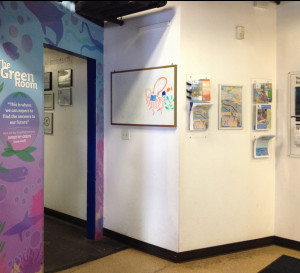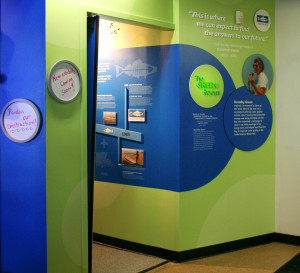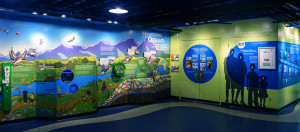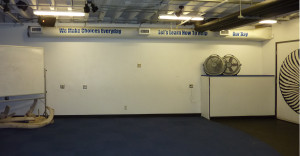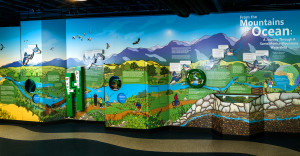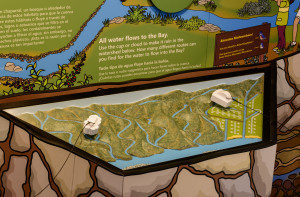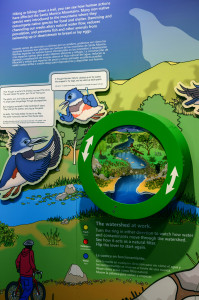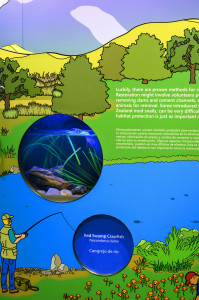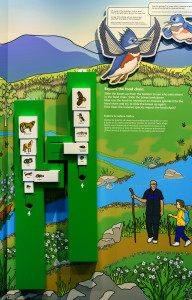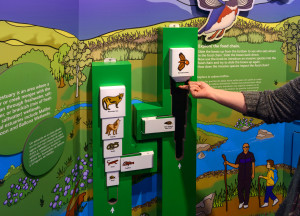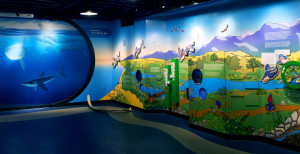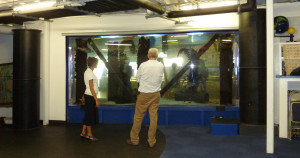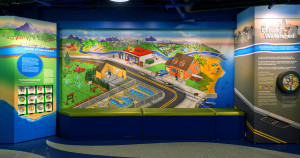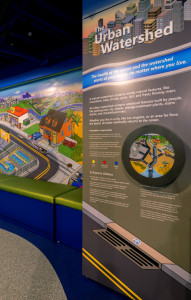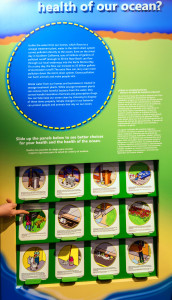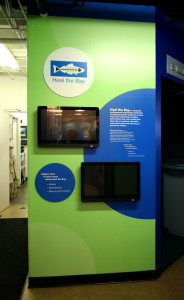Heal the Bay’s Santa Monica Pier Aquarium, with grants from The Annenberg Foundation and Prop 84, contracted with C I N N A B A R to create new exhibits for their under-utilized classroom space, The Green Room. Chris Warnock was hired on as Exhibit Designer for the project.
Several requirements needed to be met including; satisfying all requirements stipulated
by the grants, presenting information about Heal the Bay’s Founder, history, and numerous
key achievements, providing Spanish translations for all text, including durable interactives
appropriate for a wide range of ages and accessible to persons with disabilities.
In addition to information about Heal the Bay, the exhibit focuses on how visitors
can help protect the health of their local watershed and the environment. This information
is presented through large, colorful illustrations and engaging interactive elements.
The Green Room needed to serve multiple purposes. It was being used as a classroom
and lecture space, provided access to critical back-of-house areas, and was visible
from the rest of the aquarium through a large see-through tank. The new exhibits would
need to be flexible to improve the functionality of these while presenting the new content.
One entire wall of the space contains a large illustration of a natural watershed.
This needed to be scientifically accurate in its depiction of wildlife, habitat conditions,
plant life, topography, and marine life while providing adequate space for bi-lingual content.
It was important for visitors to understand that everyone lives in a watershed.
When water falls anywhere within the Santa Monica Mountains Watershed, it will
ultimately end up in Santa Monica Bay. This interactive demonstrates that fact
by allowing visitors to use a magnet to carry metal “water” bead over the landscape
and drop them. No matter where they are dropped, they roll down hillsides and
streams and finally come to rest in the Bay.
The Watershed at Work is an interactive designed to show how the natural watershed
helps filter trash and pollutants from the water before it reaches the ocean where it can
have devastating effects on the environment. Visitors turn a ring that sends beads of
various sizes rolling through a chute where different sized filters catch the larger beads,
allowing the clean “water” to flow through.
Included in the display are two live tanks with specimens that may be changed out
from time to time. Easy access for feeding, cleaning and mechanical maintenance
needed to be designed to blend with the content, while not being accessible to visitors.
Adult and juvenile Kingfisher characters were developed that appear in several places to provide whimsical commentary in rhyme to appeal to younger visitors. Another interactive element demonstrates how the food chain works and what can happen when invasive species are introduced into the environment.
Lifting a series of blocks illustrates which species eat which, the uppermost being dependent
on all the ones below it. When an invasive species block is slid into the chain, it “outcompetes”
another species, preventing the rest of the chain from being able to feed.
It was decided to keep a large, existing mural and integrate it using a portal-type
element, designed to act as a logical transition between it and the new exhibits.
A large see-through tank separates The Green Room from the rest of the aquarium. To help
minimize distractions during classroom presentations, it was decided to install a roll-up shade over the tank that could be raised or lowered as desired. Two large, black biofilter towers would also need to be masked to improve the appearance and provide additional display surfaces.
A large illustration of an Urban Watershed was designed for the face of the roll-up
shade visible inside the classroom space. The illustration shows many actions visitors
can take in their own homes and neighborhoods to improve watershed health. The biofilter
towers are now surrounded by masking panels that contain interactive elements.
An interactive demonstrates how water, trash, and pollutants flow from many sources in
an urban watershed, and are carried very rapidly to the ocean without being filtered.
Adjacent to the large Urban Watershed illustration is an interactive that challenges visitors
to examine their behavior and find better choices for the environment. Twelve sections of the illustration are shown and described on slide-up panels. When the panels are raised, a better choice is revealed.
As visitors exit The Green Room they have the opportunity to learn more by interacting with a
touch-screen display. Visitors can access Heal the Bay’s website directly, become an aquarium
member, sign up to become a volunteer, and explore the topics covered in the exhibit in further depth.
